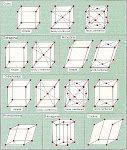Momentum is an abstract vector composed of mass and velocity for ordinary objects like cars and rocks. (See basic momentum in a straight line )
When we are working in 2 or 3 dimensions, the full weight of vector triangular addition is needed to create the CONSERVED quantity, the TOTAL MOMENTUM.
As with 1 dimensional momentum, the process is used to calculate "missing quantities" - usually the velocity of one object.
The Process of calculating these missing quantities is as for 1-D problems.
- Divide the system into "BEFORE" and "AFTER" a collision, explosion or whatever.
- Create a diagram which allows you to visualise the before and after situations
- Draw arrows for each body before and after, calculate the momentum each arrow represents, and the angles involved.
- The value you cannot calculate, give a symbol to.
- Look at the two situations - "before", "after" - for one of those you can find the TOTAL momentum
- From the above, calculate by vectors THE TOTAL MOMENTUM
- Carry this ARROW across to the other part of "before"/"after"
- Assemble the arrows of the other part so they geometrically make the TOTAL ARROW
- Use cos rule etc to find the missing part and angle.
In the above animation, a mass approaches from the left and collides with a stationary mass which then flies off. The momentum of the initial mass is the Total. Vector summing the two momenta after collision gives the intial momentum of that first mass.
Example 1
Follow this link
Example 2
Two massive objects collide then separate
Before collision

The momentum calculations become
Look now at after the collision
Calculate the total based knowing the total is the same red arrow as from earlier.

Categories:
animation


0 comments:
Posting Komentar